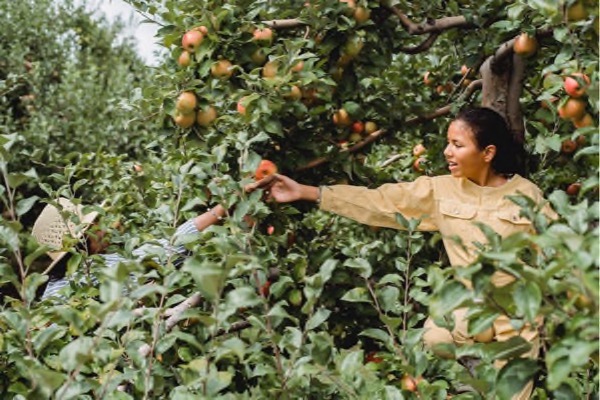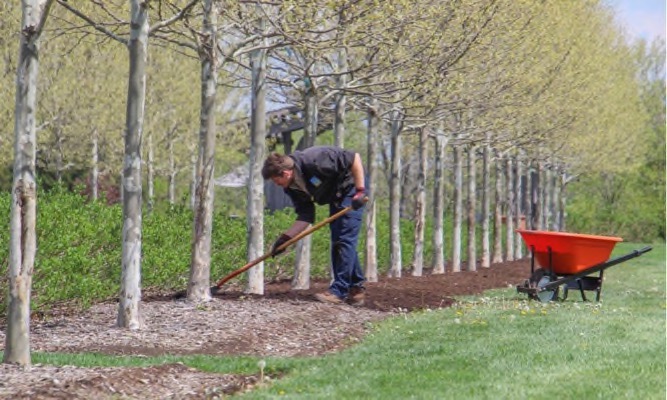Sustainable gardening refers to minimizing the human impact on the earth. At home, sustainable gardening involves avoiding pollutants in fertilizers, preserving resources, and reducing waste. Transitioning to sustainable gardening doesn’t require immediate drastic changes. Even substituting natural weed-killing methods instead of chemicals can benefit the environment. Implementing these ideas contributes to a happier and healthier planet.


How do you make a green garden?
#1 Mulch
Mulching not only prevents the growth of weeds in your garden but also aids in retaining soil moisture. This is particularly crucial in water-restricted areas. Apply a 2 to 3-inch layer of your preferred mulch to garden beds and around landscape plants. Eco-friendly gardening options include shredded bark, cocoa bean hulls, pine needles, grass clippings, and coir (derived from coconut hulls).
#2 Water Less
In areas with limited water resources, promoting sustainability involves minimizing water usage. Xeriscaping, a landscaping technique that reduces the need for watering, incorporates attractive shrubs and perennials that can tolerate drought. Installing a rain barrel at the base of one or more downspouts allows for collecting rainwater from nature to nourish your plants.
#3 Choose the right plants
To develop a sustainable garden, it is important to select appropriate plants. Indigenous plants, also known as natives, are considered sustainable. They require less maintenance, utilize less water, and thrive in your specific climate, rainfall, and soil conditions. Moreover, native plant species support the local insect and bird populations by providing food and shelter.
What plants are best for a sustainable garden? These aren’t necessarily native plants, but the app for plants can help you find the perfect plant species. A special plant identifier app helps you select plants depending on your conditions: amount of lighting, moisture level, and average temperature. This recognize plant app can recognize applications through photos or cameras too. Moreover, the app for iPhone has a built-in scanner and filter.
#4 Reduce energy consumption
Your lawn is a major contributor to outdoor energy consumption. Whenever feasible, choose an electric or push-reel mower and maintain a sharp blade for optimal efficiency. Pulling weeds manually before mowing can prevent them from spreading across your lawn and garden.
To reduce lawn size, consider planting trees, and shrubs, or expanding your garden. Most gardens rely solely on renewable energy, but if you choose to use lighting, opt for solar-powered LED bulbs instead of fluorescent ones. Not only are they more energy-efficient, but they also provide a natural outdoor lighting effect for your garden and landscape.
#5 Plant perennials
Long-lasting perennials offer great value for your gardening investment. Select perennials suitable for your USDA Zone, and the plant tag usually provides zone information. Purchase young perennials to save money; they will grow and improve with each passing year. Periodically divide them to create more plants for sustainable gardening or sharing with friends.
#6 Go Organic
Embracing organic practices plays a vital role in fostering sustainable gardening. Opting for fewer chemicals not only promotes ecological soundness but also proves cost-effective. For those cultivating food for their families, the significance of organic gardening becomes even more pronounced. Begin by establishing fertile soil abundant in nutrients and supplementing it with natural compost. In case of encountering garden pests or plant diseases, tackle them using organic remedies.
#7 Use peat
The world’s peatlands are the largest carbon store on land and offer vital ecosystems for plants and animals. By acting as sponges, they also reduce the risk of flooding.
When we extract peat for gardening purposes, it releases carbon and harms habitats. Preserving peat within bogs, rather than in bags, plays a pivotal role in combating climate change. Our planet’s vast expanse of peat spans billions of acres and holds more carbon than all the forests on Earth combined.


#8 Improve soil health
Soil plays a crucial role in establishing a sustainable garden as it captures and stores carbon, and provides a habitat for countless microorganisms and small creatures that contribute to the planet’s well-being. Enhancing soil quality is also one of several wildlife garden ideas.
Garden designer Tom Massey advises against disturbing the soil to prevent the release of carbon trapped beneath its surface. Instead, only dig when planting. Learning how to create compost and layering the soil with organic matter or leaf mulch will enhance soil structure and deliver nutrients directly to plant roots. This practice stimulates worms and other creatures to break down the organic matter further, resulting in healthier soil overall.
Conclusion
Living sustainably is not just a gift to the Earth, it is an investment in yourself and the lives of your children. There is so much more you can learn about living a green lifestyle. How do you make an eco-friendly path? How to choose food correctly? What drugs are safe to treat vegetables with? This will be a reason for you to think about the future.
